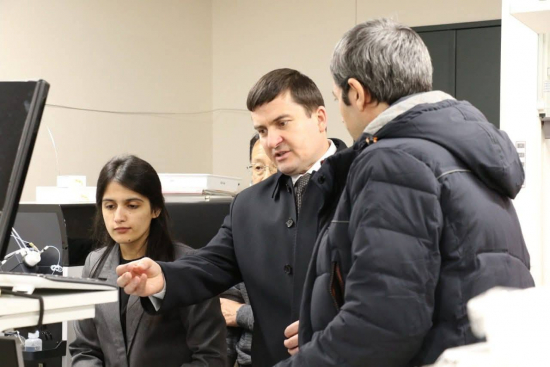On December 3, 2019, the President of the National Academy of Sciences of Tajikistan, Corresponding Member of the National Academy of Sciences of Tajikistan Khushvakhtzoda Kobiljon Khushvakht visited the water quality analysis laboratory at Akita University in Japan.
During the visit, I prepared a groundwater sample that we collected last year for ion chromatography to determine the content of cations and anions. I also prepared a presentation and informed the President of the National Academy of Sciences of Tajikistan, Corresponding Member of the National Academy of Sciences of Tajikistan Khushvakhtzoda Kobiljon Khushvakht about my activities in the Satreps project at Akita University in Japan, where sanitary and technical measures are carried out to eliminate pathogens transmitted through water. After a complete analysis of the water composition, its quality is determined and at the same time it is disinfected using chemicals (for example, chlorine, ozone, iodine, silver ions) or physical methods (boiling, ultraviolet irradiation, ultrasound, gamma radiation).
This laboratory operates at Akita University in Japan, and young researchers, graduate and postgraduate students are engaged in scientific research here. At the same time, this laboratory recruits young researchers from the National Academy of Sciences of Tajikistan for an internship, where they hone their modern knowledge.
During the visit to the laboratory, the Presidenчt of the National Academy of Sciences of Tajikistan, Corresponding Member Khushvakhtzoda Kobiljon Khushvakht talked with young researchers of the National Academy of Sciences of Tajikistan and noted that the continuous support of the Founder of Peace and National Unity - Leader of the Nation, President of the Republic of Tajikistan Emomali Rahmon was more than enough for the youth. Therefore, young researchers need to improve their knowledge.
On December 13-15, Professor Daizo Ishiyama conducted a tour of the wastewater treatment plant at Radbow Sewer Hall in Tokyo. At the Tokyo Prefectural Water Treatment Plant, the company's employees held a presentation on the purification and disinfection of wastewater from the Tokyo Prefectural Water Supply System. Then we were shown a chemical and biological laboratory, a multi-stage purification plant, and a hypochlorination section on the monitor. Then I studied with Professor Ishiyama Daizo in Tokyo. I observed wastewater treatment at a sewage treatment plant called the Radbow Sewer Hall in Tokyo. Here, bacteria are used to purify wastewater, which is then discharged into the ocean. In addition, I conducted an experiment here to help children understand the importance of maintaining good water quality. This photo shows the experiment. I want to apply this experience to environmental education for children and ordinary people in Tajikistan.
Then we visited the Daigo Fukuru Meru Museum. In 1954, the United States tested a hydrogen bomb in the Marshall Islands in the South Pacific. These clouds are artificial clouds made of highly radioactive particles. White power is the particles.
At the time of the hydrogen bomb test, 23 Japanese fishermen were on a fishing boat near the test site. Highly radioactive particles were found on the fishermen's skin.
Fishermen suffered burns and radiation injuries from highly radioactive particles. One fisherman died six months after the incident. Other tourists suffered from radiation exposure for many years. During this trip, I learned about the effects of radiation from uranium and other materials on the human body.
The concentration of uranium in Dushanbe groundwater is low. The intensity of radiation from this uranium may be weak. Therefore, the health effects are not so serious.
In the future, if we find groundwater with a high concentration of uranium, we should know about it.
Junior Researcher
CIDS A NT NAST Nadzhmudinova F.I.
Scientific activities
Publications and inventions
Work schedule
Center of the Innovative Development of Science and New Technologies of NAST
- Monday - Friday 8.00 - 17.00
- Saturday: Day off
- Sunday: Day off
Contacts
Address: Dushanbe, 33 Rudaki Ave., third floor, new building of NAST
- Email : info@cidsnt.tj
- Phone: (+992 37) 221-35-67




